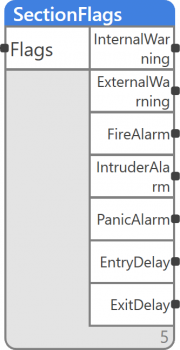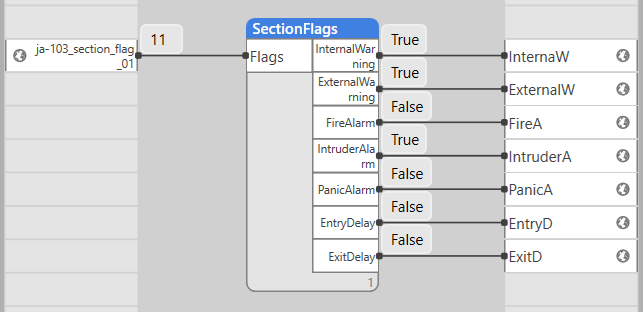Table of Contents
SectionFlags
Block name
SectionFlags
ST call
PROGRAM TEST_SectionFlags VAR USINT1: USINT; BOOL1,BOOL2,BOOL3,BOOL4,BOOL5,BOOL6,BOOL7: BOOL; END_VAR FB(Flags:=USINT1, InternalWarning:= BOOL1, ExternalWarning:= BOOL2 FireAlarm:= BOOL3, IntruderAlarm:= BOOL4, PanicAlarm:= BOOL5, EntryDelay:= BOOL6, Exithelay:= BOOL7); END_PROGRAM
Library
LIB\JABLOTRON
Version
V1.0
Description
The block divides the Flags input value into individual bits. These bits are then represented on the output.
Inputs
| Input | Type | Description | Default value |
|---|---|---|---|
| Flags | USINT | Current flags of the section | 0 |
Outputs
| Output | Type | Description |
|---|---|---|
| InternalWarning | BOOL | Internal alarm horn message |
| ExternalWarning | BOOL | External alarm horn message |
| FireAlarm | BOOL | Fire alarm |
| IntruderAlarm | BOOL | Intruder alarm |
| PanicAlarm | BOOL | Panic alarm |
| EntryDelay | BOOL | Entry delay |
| ExitDelay | BOOL | Exit delay |
Function
The block reads the section’s flag value containing info about all flags of the section. The read value is transformed into an individual bit according to a bitmask. Each bit is written onto the corresponding output. According to its position, the bit may have multiple meanings, as listed in the table below.
Bitmask
| Bit position | Bit meaning |
|---|---|
| 1 | Internal Warning |
| 2 | External Warning |
| 4 | Fire Alarm |
| 8 | Intruder Alarm |
| 16 | Panic Alarm |
| 32 | Entry Delay |
| 64 | Exit Delay |
| 0 | Default flag value |

